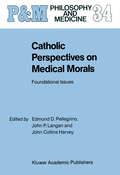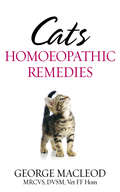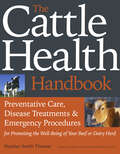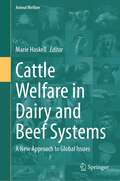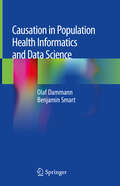- Table View
- List View
Catheter Ablation of Cardiac Arrhythmias E-Book
by Kalyanam Shivkumar Shoei K. Stephen Huang Jason S. BradfieldWritten and edited by world-renowned experts in the field, including Dr. Shoei K. Stephen Huang, a pioneer of radiofrequency catheter ablation procedures, Huang's Catheter Ablation of Cardiac Arrhythmias, 5th Edition, provides authoritative, comprehensive information on these increasingly used electrophysiology procedures. This outstanding resource is packed with cutting-edge content in every area of this fast-changing field, including anatomy, diagnostic criteria, differential diagnosis, mapping, and ablation. Ideal for practitioners who need a definitive, user-friendly ablation text for the electrophysiology lab or office setting, it offers quick access to practical content, using detailed tables and high-quality images to help you apply what you learn in your practice.Reflects all the latest technology, including the new pulse field ablation (PFA) procedure, new balloon technologies (RF, laser, and PFA) for pulmonary vein isolation, and high-resolution 3D mapping systems.Offers expert guidance on atrial tachycardia and flutter, atrial fibrillation, atrioventricular nodal reentrant tachycardia, tachycardias related to accessory atrioventricular connections, ventricular tachycardia, transseptal catheterization techniques, ablation for pediatric patients, and patient safety and complications.Contains new chapters covering Biophysics and Clinical Applications of Laser Ablation, Biophysics and Clinical Applications of Pulse Field Ablation, Multiple Strategic Approach to Ablate Atrial Fibrillation, Ablation of Challenging/Difficult Accessory Pathways, Ablation of Ventricular Tachycardia in Arrhythmogenic Ventricular Cardiomyopathy, and more.Contains 450 figures, including ECGs, intracardiac recordings, 3D mapping, ultrasound, fluoroscope, and ablation images.Includes numerous tables and boxes that provide quick access to key points, arrhythmia mechanisms, diagnostic criteria, target sites for ablation, use of special equipment, complications, and troubleshooting problems and their solutions.Provides access to 20 video clips, including transseptal access to the left atrium, intracardiac ultrasound, and techniques of pericardial access.Any additional digital ancillary content may publish up to 6 weeks following the publication date.
Catheter Ablation of Cardiac Arrhythmias in Children and Patients with Congenital Heart Disease
by Edward P. Walsh George F. Van Hare Paul Khairy Mohammad ShenasaThis authoritative book explores electrophysiologic testing and therapeutic catheter ablation for cardiac arrhythmias in children, and in patients of all ages with congenital heart disease. It reviews the anatomic and physiologic background to these procedures, emphasizing the tools for mapping and tissue ablation that continue to improve patient outcomes. Additionally, individual chapters are dedicated to specific congenital heart defects (for instance, tetralogy of Fallot, Ebstein’s anomaly, univentricular heart) guiding the reader to anticipate the type of arrhythmia, the most likely location for effective ablation, and the technical challenges that may be encountered in each condition. Key Features Provides a detailed review of the unique challenges presented by young patients with small heart size, and patients of any age with distorted anatomy due to congenital heart disease, in this long overdue, updated text Intends to guide all cardiologists engaged in invasive electrophysiology at both the training level and established practice who are exposed to such exceptional cases Includes an internationally recognized group of experts who discuss the technical approaches, success rates, complication rates, and special precautions needed to achieve optimal outcomes
Catheter Ablation of Cardiac Arrhythmias in Children and Patients with Congenital Heart Disease
by Edward P. Walsh George F. Van Hare Paul Khairy Mohammad ShenasaThis authoritative book explores electrophysiologic testing and therapeutic catheter ablation for cardiac arrhythmias in children, and in patients of all ages with congenital heart disease. It reviews the anatomic and physiologic background to these procedures, emphasizing the tools for mapping and tissue ablation that continue to improve patient outcomes. Additionally, individual chapters are dedicated to specific congenital heart defects (for instance, tetralogy of Fallot, Ebstein’s anomaly, univentricular heart) guiding the reader to anticipate the type of arrhythmia, the most likely location for effective ablation, and the technical challenges that may be encountered in each condition. Key Features Provides a detailed review of the unique challenges presented by young patients with small heart size, and patients of any age with distorted anatomy due to congenital heart disease, in this long overdue, updated text Intends to guide all cardiologists engaged in invasive electrophysiology at both the training level and established practice who are exposed to such exceptional cases Includes an internationally recognized group of experts who discuss the technical approaches, success rates, complication rates, and special precautions needed to achieve optimal outcomes
Catheter-Based Cardiovascular Interventions: A Knowledge-Based Approach
by Peter LanzerOperator skills, and in particular decision-making and strategic skills, are the most critical factor for the outcome of catheter-based cardiovascular interventions. Currently, such skills are commonly developed by the empirical trial and error method only. In this textbook, for the first time, an explicit teaching, training, and learning approach is set out that will enable interventional operators, whether cardiologists, vascular surgeons, vascular specialists, or radiologists, to learn about and to develop the cognitive skills required in order to achieve consistent expert-level catheter-based interventions. It is anticipated that adoption of this approach will allow catheter-based interventions to become a domain of excellence, with rapid transfer of knowledge, steep learning curves, and highly efficient acquisition of complex skills by individual operators — all of which are essential to meet successfully the challenges of modern cardiovascular care.
Catheter Based Valve and Aortic Surgery
by Gorav Ailawadi Irving L. KronThis text provides a comprehensive, state-of-the-art review of catheter based approaches to valve and aortic diseases. The scope encompasses involve all the current and upcoming transcatheter aortic valve technologies as well as mitral, pulmonary and tricuspid valve technologies. Aortic diseases including transcatheter repair of descending aneurysms are included and the upcoming technologies designed to repair aortic dissections, traumatic injury, and ascending arch stent repair are highlighted. Catheter Based Valve and Aortic Surgery will be a useful tool for cardiac and vascular surgeons, interventional cardiologists, general cardiologists, and clinicians and researchers with an interest in these exciting new developments in structural heart and vascular diseases.
Catheter-Related Infections
by Harald Seifert Bernd Jansen Barry FarrThis updated reference describes the latest and most effective strategies in the diagnosis, management, and treatment of catheter-related infections (CRIs). The guide describes the pathogenesis of infectious complications while discussing procedures in infection control, catheter and catheter-site care, and patient monitoring and evaluation. This n
Catheter-Related Infections (Infectious Disease And Therapy Ser.)
by Harald Seifert Bernd Jansen Barry M. FarrThis updated reference describes the latest and most effective strategies in the diagnosis, management, and treatment of catheter-related infections (CRIs). The guide describes the pathogenesis of infectious complications while discussing procedures in infection control, catheter and catheter-site care, and patient monitoring and evaluation. This n
Catheter-Related Infections in the Critically Ill (Perspectives on Critical Care Infectious Diseases #8)
by DidierPittet Naomi P. O’GradyCatheter-Related Infections in the Critically Ill provides an overview from an international perspective on intravascular catheters and the risk of infection. This volume highlights:EpidemiologyDiagnosis Impact of Infection Management and Treatment Prevention - including Education as the Primary Tool for PreventionThe purpose of this book is to provide the practitioner with the most interesting and useful data in the field of catheter-related infection. It is hoped that the strategies to prevent infection detailed by the authors will be implemented and have a measurable impact in decreasing rates of infection in the intensive care unit setting.
Catholic Perspectives on Medical Morals: Foundational Issues (Philosophy and Medicine #34)
by Edmund D. Pellegrino J. Langan John Collins HarveyCATHOLIC PERSPECTIVES AND CONTEMPORARY MEDICAL MORALS A Catholic perspective on medical morals antedates the current world wide interest in medical and biomedical ethics by many centuries[5]. Discussions about the moral status of the fetus, abortion, contraception, and sterilization can be found in the writings of the Fathers and Doctors of the Church. Teachings on various aspects of medical morals were scattered throughout the penitential books of the early medieval church and later in more formal treatises when moral theology became recog nized as a distinct discipline. Still later, medical morality was incorpor ated into the many pastoral works on medicine. Finally, in the contemporary period, works that strictly focus on medical ethics are produced by Catholic moral theologians who have special interests in matters medical. Moreover, this long tradition of teaching has been put into practice in the medical moral directives governing the operation of hospitals under Catholic sponsorship. Catholic hospitals were monitored by Ethics Committees long before such committees were recommended by the New Jersey Court in the Karen Ann Quinlan case or by the President's Commission in 1983 ([8, 9]). Underlying the Catholic moral tradition was the use of the casuistic method, which since the 17th and 18th centuries was employed by Catholic moralists to study and resolve concrete clinical ethical dilem mas. The history of casuistry is of renewed interest today when the case method has become so widely used in the current revival of interest in medical ethics[ll].
Cation Binding by Macrocycles: Complexation of Cationic Species by Crown Ethers
by Yoshihisa Inoue George W. GokelThis reference details the theory and application of cation complexation, including the design and synthesis of various cyclic systems, these materials' use as transport systems, in complexation and selectivity studies by macrocyclic systems, and methodologies for understanding these phenomena. In a
Cation Binding by Macrocycles: Complexation of Cationic Species by Crown Ethers
by Yoshihisa Inoue George W. GokelThis reference details the theory and application of cation complexation, including the design and synthesis of various cyclic systems, these materials' use as transport systems, in complexation and selectivity studies by macrocyclic systems, and methodologies for understanding these phenomena. In a
Cats: Homoeopathic Remedies
by George MacleodThis book is written to satisfy the needs of the increasing numbers of cat lovers who are interested in alternative methods to treat the illnesses to which their pets may fall prey. This comprehensive guide introduces the principles of homoeopathy and the nature of homoeopathic remedies, explaining how remedies can be prepared and administered. There are informative sections on treating the different feline bodily systems and the specific diseases that cats may suffer from. There is also advice on treating common feline ailments such as parasites, wounds and injuries.
Cats are not Peas: A Calico History of Genetics
by Laura L. GouldCats are Not Peas, narrated with inimitable grace and wit, takes us through the great discoveries in genetics, from Mendel's studies of inheritance in peas through the discovery of the chromosome and the role of DNA - all from the little-known viewpoint of the pivotal and unheralded role played by cats as experimental subjects in this epic drama."...the book was difficult to put down...Coherent, witty, and full of historical anecdotesany intelligent reader should be able to accompany Gould on her quest." -NEW SCIENTIST"A delightful and painless introduction to genetics and its colorful history..." -WINSLOW R. BRIGGS, CARNEGIE INSTITUTE OF WASHINGTON
Cattle and Sheep Medicine: Self-Assessment Color Review (Veterinary Self-Assessment Color Review Series)
by Philip R. ScottThe new edition of Cattle and Sheep Medicine incorporates over 250 new clinical cases divided equally between cattle and sheep. The cases appear randomly to reflect real life practice and are presented as a set of integrated questions, photographs and detailed explanatory answers-to educate and not just to test. New images have been added for all c
Cattle and Sheep Medicine: Self-Assessment Color Review (Veterinary Self-Assessment Color Review Series)
by Philip R. ScottThe new edition of Cattle and Sheep Medicine incorporates over 250 new clinical cases divided equally between cattle and sheep. The cases appear randomly to reflect real life practice and are presented as a set of integrated questions, photographs and detailed explanatory answers-to educate and not just to test. New images have been added for all c
Cattle Behaviour and Welfare
by Clive PhillipsCattle are one of our major domesticated animals, a higher mammal with complex mental and physical needs. The benefit of a knowledge of cattle behaviour means veterinarians and stockpeople can recognise abnormal behaviour signs for disease diagnosis and indication of an inadequate environment. This book replaces the book Cattle Behaviour, written by the same author and published by Farming Press in 1993. The text has been revised and updated and four new chapters on cattle welfare have been added. The main interest of many reading a book on behaviour is its relation to the welfare of the species, so the combination of welfare and behaviour is a logical one.
The Cattle Health Handbook
by Heather Smith ThomasIn this practical guide, Heather Smith Thomas provides easy-to-execute solutions for a variety of common medical situations that can afflict your animals, including bacterial diseases, parasites, and nutritional deficiencies.
Cattle Plague: A History
by Clive SpinageCattle Plague: A History is divided into five sections, dealing with the nature of the virus, followed by a chronological history of its occurrence in Europe from the Roman Empire to the final 20th century outbreaks; then administrative control measures through legislation, the principal players from the 18th century, followed by an analysis of some effects, political, economic and social. Then follows attempts at cure from earliest times encompassing superstition and witchcraft, largely Roman methods persisting until the 19th century; the search for a cure through inoculation and the final breakthrough in Africa at the end of the 19th century. The last section covers the disease in Asia and Africa. Appendices cover regulations now in force to control the disease as well as historical instructions, decrees and statutes dating from 1745-1878.
Cattle Welfare in Dairy and Beef Systems: A New Approach to Global Issues (Animal Welfare #23)
by Marie HaskellThis book provides a comprehensive coverage of all aspects of the welfare of cattle. It starts with a consideration of animal welfare science and its application to the management of cattle and moves through to discussions of the challenges and opportunities for providing good welfare for cattle in farming and husbandry systems across the globe. The first section comprises three chapters that discuss the social, behavioural and physiological methods that can be used to assess welfare in cattle. The second section considers the welfare challenges of beef and dairy cattle in extensive and intensive systems. The third section details welfare challenges such as at slaughter, during handling and in the growing period and details solutions such as the use of sensors and application of animal breeding techniques. The final section addresses welfare challenges and solutions in achieving sustainability, in smallholder farms in Africa and new entrant dairying in Asia and cow shelters in India. This work makes a valuable contribution to the field of animal welfare and modern livestock farming. It is a must-read for researchers and students, veterinarians as well as industry personnel and informed farmers and producers.
Caught In A Storm Of Passion: The Greek Doctor's Secret Son / Caught In A Storm Of Passion (Mills And Boon Medical Ser. #2)
by Lucy RyderDr Evelyn Carmichael’s plan: 1. Travel to the South Pacific and stop her sister marrying the wrong man. 2. Leave as quickly as possible and refocus on her career. 3. Avoid all men along the way—they’re nothing but trouble!
Causality and Psychopathology: Finding the Determinants of Disorders and their Cures (American Psychopathological Association)
by Patrick Shrout Katherine Keyes Katherine OrnsteinPart of the new American Pyschopathological Association Series. Containing contributions from leading scholars of causal thinking in epidemiology and psychopathology research, this volume is based on presentations at the ground-breaking 2008 meeting of the American Psychopathological Association. The authors explore the meaning of causal statements that are made from statistical and experimental evidence; then, they suggest novel approaches to analyze these statements and thus make them more informative and medically rigorous. The collection of chapters uniquely includes both methodological contributions and detailed assessments of how causal inferences can be made when considering research results on developmental psychopathology, clinical psychopharmacology, personality disorders, post-traumatic stress disorder, and psychiatric genetics. In analyzing causal references, the authors examine controversies surrounding various disorders and their treatment.
The Causation and Clinical Management of Pelvic Radiation Disease
by E. W. Lupton P. F. SchofieldMaterial for this book was gathered in the early 1980's in Manchester, where a higher incidence than usual of complications in the gastro-intestinal and urinary tract was observed. Part I describes the principles and methods of radiotherapy for pelvic tumours, pathological features and radiological analysis of bowel and urinary tract changes. Parts II and III are devoted to clinical assessment and management, where the need for a multi-diciplinary approach is emphasized.
Causation and Disease: A Chronological Journey
by EVANSIn the front material of this book both a foreword and a preface appear. What the content of a preface should be is well understood. It is the author's retrospective account of intent, of the labors to accomplish that intent, and of the content of the book that resulted. What a foreword should be is less obvious. Most properly, it is perhaps the brief testimony of one who knows the accomplishments of the author and the scope of the field and who may direct readers to the book. On some basis, the writer is assumed to have earned the right to undertake such a task. To undertake the writing of a foreword for so considerable a researcher, teacher, and scholar as Alfred Evans can be seen not only as an honor but also as a daunting one. My first thought, in truth, is that this wine needs no blush and that no foreword is needed. As John Rodman Paul Professor of Epidemiology at Yale, Alfred Evans has an established reputation in the field of causality. We have learned from his insights about the evolution of causal thinking as epidemiology passed from the era of the germ theory into that of the search for causes of chronic noncontagious diseases. It was he who drew attention to the effect of specific context in that evolution.
Causation and Prevention of Human Cancer: Proceedings of the 8th Annual Symposium of the European Organization for Cooperation in Cancer Prevention Studies (ECP), Heidelberg, Germany, April 2–3,1990 (Developments in Oncology #63)
by AttilioGiacosa Michael JHillThe European Organization for Cooperation in Cancer Prevention Studies (ECP) was established in 1981 to promote collaboration between scientists working in the various European countries on cancer causation and prevention. In order to achieve this aim, various working group- to deal with specific cancers or aspects of cancer aetiology, and to explore the opportunities for advances on a cooperative European basis - were established. It was also decided to hold annual symposia to draw general attention to fields in which there seemed to be many opportunities for progress in matters of prevention. These symposia have been devoted to themes of high priority to cancer prevention: "Tobacco and Cancer" (1983), "Hormones and Sexual Factors in Human Cancer Aetiology" (1984), "Diet and Human Carcinogenesis" (1985), "Concepts and Theories in Carcinogenesis" (1986)," Preventive Strategies for Cancer related to Immune Deficiencies" (1987), "Gastric Carcinogenesis" (1988), and "Breast, Ovarian and Endometrial Cancer: Aetiological and Epidemiological Relationships" (1989). This volume contains the proceedings of the 1990 ECP symposium held in Heidelberg, FRG, at the Deutsches Krebsforschungszentrum (DKFZ), on April 2-3 on "Causation and Prevention of Human Cancer". We are indebted to the speakers for their contribution during the symposium and for their prompt submission of manuscripts. We are grateful to the sponsors, SmithKline Diagnostics and Rohm Pharma. Our special thanks go to Dr M.C. stanei-Gueur for preparing and typing the camera forms of all manuscripts.
Causation in Population Health Informatics and Data Science
by Olaf Dammann Benjamin SmartMarketing text: This book covers the overlap between informatics, computer science, philosophy of causation, and causal inference in epidemiology and population health research. Key concepts covered include how data are generated and interpreted, and how and why concepts in health informatics and the philosophy of science should be integrated in a systems-thinking approach. Furthermore, a formal epistemology for the health sciences and public health is suggested. Causation in Population Health Informatics and Data Science provides a detailed guide of the latest thinking on causal inference in population health informatics. It is therefore a critical resource for all informaticians and epidemiologists interested in the potential benefits of utilising a systems-based approach to causal inference in health informatics.






